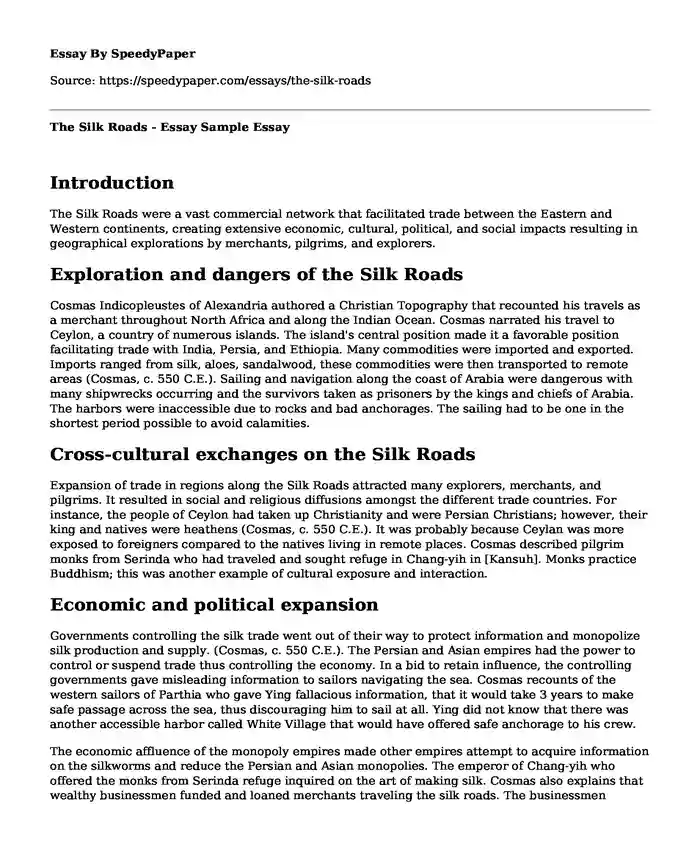
| Type of paper: | Essay |
| Categories: | History Culture Historical events & places |
| Pages: | 3 |
| Wordcount: | 557 words |
Introduction
The Silk Roads were a vast commercial network that facilitated trade between the Eastern and Western continents, creating extensive economic, cultural, political, and social impacts resulting in geographical explorations by merchants, pilgrims, and explorers.
Exploration and dangers of the Silk Roads
Cosmas Indicopleustes of Alexandria authored a Christian Topography that recounted his travels as a merchant throughout North Africa and along the Indian Ocean. Cosmas narrated his travel to Ceylon, a country of numerous islands. The island's central position made it a favorable position facilitating trade with India, Persia, and Ethiopia. Many commodities were imported and exported. Imports ranged from silk, aloes, sandalwood, these commodities were then transported to remote areas (Cosmas, c. 550 C.E.). Sailing and navigation along the coast of Arabia were dangerous with many shipwrecks occurring and the survivors taken as prisoners by the kings and chiefs of Arabia. The harbors were inaccessible due to rocks and bad anchorages. The sailing had to be one in the shortest period possible to avoid calamities.
Cross-cultural exchanges on the Silk Roads
Expansion of trade in regions along the Silk Roads attracted many explorers, merchants, and pilgrims. It resulted in social and religious diffusions amongst the different trade countries. For instance, the people of Ceylon had taken up Christianity and were Persian Christians; however, their king and natives were heathens (Cosmas, c. 550 C.E.). It was probably because Ceylan was more exposed to foreigners compared to the natives living in remote places. Cosmas described pilgrim monks from Serinda who had traveled and sought refuge in Chang-yih in [Kansuh]. Monks practice Buddhism; this was another example of cultural exposure and interaction.
Economic and political expansion
Governments controlling the silk trade went out of their way to protect information and monopolize silk production and supply. (Cosmas, c. 550 C.E.). The Persian and Asian empires had the power to control or suspend trade thus controlling the economy. In a bid to retain influence, the controlling governments gave misleading information to sailors navigating the sea. Cosmas recounts of the western sailors of Parthia who gave Ying fallacious information, that it would take 3 years to make safe passage across the sea, thus discouraging him to sail at all. Ying did not know that there was another accessible harbor called White Village that would have offered safe anchorage to his crew.
The economic affluence of the monopoly empires made other empires attempt to acquire information on the silkworms and reduce the Persian and Asian monopolies. The emperor of Chang-yih who offered the monks from Serinda refuge inquired on the art of making silk. Cosmas also explains that wealthy businessmen funded and loaned merchants traveling the silk roads. The businessmen earned from the loans granted to merchants to facilitate their travel and trade activities along the Silk Roads.
The Silk Roads had a global impact because it resulted in trans-continental trade. The numerous interactions created opportunities for information to be shared, new products introduced to Europe from Asian and Persia. It also led to cross-cultural exchanges leading to the spread of Christianity and Buddhism. Moreover, the economic and political factors led to the expansion of dynasties, especially for Asia and Persia. The impact of the Silk Roads in trade today is seen in the thriving global trade and exchange platforms across the world.
Reference
Cosmas Indicopleustes (c. 550 C.E.). Selection from Christian Topography.
Cite this page
The Silk Roads - Essay Sample. (2023, Dec 30). Retrieved from https://speedypaper.com/essays/the-silk-roads
Request Removal
If you are the original author of this essay and no longer wish to have it published on the SpeedyPaper website, please click below to request its removal:
- Free Essay Sample about Roman Coins
- Free Essay: International Organization Concepts in the Example of Henkel Company
- Spanish-American War - Free Essay in History
- Essay Example: George Washington's Leadership during the American Revolution
- Essay Sample on Summary of the Main Ideas Presented in the Video
- Staff and Line Positions - Free Essay Example
- Free Essay Example: Articles of Confederation
Popular categories




